Lin Gu
RealX3D: A Physically-Degraded 3D Benchmark for Multi-view Visual Restoration and Reconstruction
Dec 29, 2025Abstract:We introduce RealX3D, a real-capture benchmark for multi-view visual restoration and 3D reconstruction under diverse physical degradations. RealX3D groups corruptions into four families, including illumination, scattering, occlusion, and blurring, and captures each at multiple severity levels using a unified acquisition protocol that yields pixel-aligned LQ/GT views. Each scene includes high-resolution capture, RAW images, and dense laser scans, from which we derive world-scale meshes and metric depth. Benchmarking a broad range of optimization-based and feed-forward methods shows substantial degradation in reconstruction quality under physical corruptions, underscoring the fragility of current multi-view pipelines in real-world challenging environments.
Perception-Inspired Color Space Design for Photo White Balance Editing
Dec 11, 2025Abstract:White balance (WB) is a key step in the image signal processor (ISP) pipeline that mitigates color casts caused by varying illumination and restores the scene's true colors. Currently, sRGB-based WB editing for post-ISP WB correction is widely used to address color constancy failures in the ISP pipeline when the original camera RAW is unavailable. However, additive color models (e.g., sRGB) are inherently limited by fixed nonlinear transformations and entangled color channels, which often impede their generalization to complex lighting conditions. To address these challenges, we propose a novel framework for WB correction that leverages a perception-inspired Learnable HSI (LHSI) color space. Built upon a cylindrical color model that naturally separates luminance from chromatic components, our framework further introduces dedicated parameters to enhance this disentanglement and learnable mapping to adaptively refine the flexibility. Moreover, a new Mamba-based network is introduced, which is tailored to the characteristics of the proposed LHSI color space. Experimental results on benchmark datasets demonstrate the superiority of our method, highlighting the potential of perception-inspired color space design in computational photography. The source code is available at https://github.com/YangCheng58/WB_Color_Space.
EGTM: Event-guided Efficient Turbulence Mitigation
Sep 04, 2025Abstract:Turbulence mitigation (TM) aims to remove the stochastic distortions and blurs introduced by atmospheric turbulence into frame cameras. Existing state-of-the-art deep-learning TM methods extract turbulence cues from multiple degraded frames to find the so-called "lucky'', not distorted patch, for "lucky fusion''. However, it requires high-capacity network to learn from coarse-grained turbulence dynamics between synchronous frames with limited frame-rate, thus fall short in computational and storage efficiency. Event cameras, with microsecond-level temporal resolution, have the potential to fundamentally address this bottleneck with efficient sparse and asynchronous imaging mechanism. In light of this, we (i) present the fundamental \textbf{``event-lucky insight''} to reveal the correlation between turbulence distortions and inverse spatiotemporal distribution of event streams. Then, build upon this insight, we (ii) propose a novel EGTM framework that extracts pixel-level reliable turbulence-free guidance from the explicit but noisy turbulent events for temporal lucky fusion. Moreover, we (iii) build the first turbulence data acquisition system to contribute the first real-world event-driven TM dataset. Extensive experimental results demonstrate that our approach significantly surpass the existing SOTA TM method by 710 times, 214 times and 224 times in model size, inference latency and model complexity respectively, while achieving the state-of-the-art in restoration quality (+0.94 PSNR and +0.08 SSIM) on our real-world EGTM dataset. This demonstrating the great efficiency merit of introducing event modality into TM task. Demo code and data have been uploaded in supplementary material and will be released once accepted.
ToolGrad: Efficient Tool-use Dataset Generation with Textual "Gradients"
Aug 06, 2025Abstract:Prior work synthesizes tool-use LLM datasets by first generating a user query, followed by complex tool-use annotations like DFS. This leads to inevitable annotation failures and low efficiency in data generation. We introduce ToolGrad, an agentic framework that inverts this paradigm. ToolGrad first constructs valid tool-use chains through an iterative process guided by textual "gradients", and then synthesizes corresponding user queries. This "answer-first" approach led to ToolGrad-5k, a dataset generated with more complex tool use, lower cost, and 100% pass rate. Experiments show that models trained on ToolGrad-5k outperform those on expensive baseline datasets and proprietary LLMs, even on OOD benchmarks.
Spatial Frequency Modulation for Semantic Segmentation
Jul 16, 2025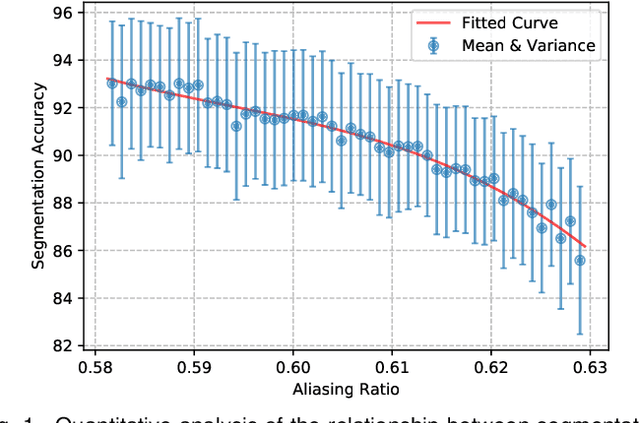
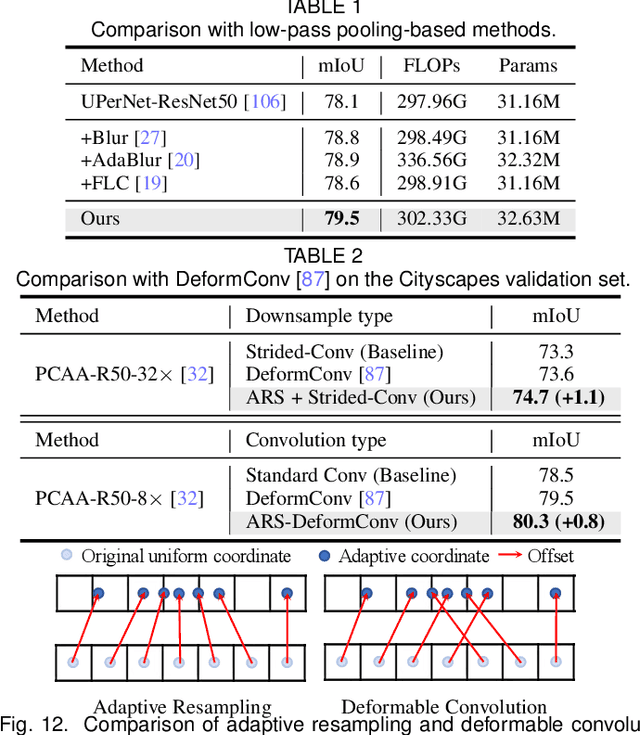
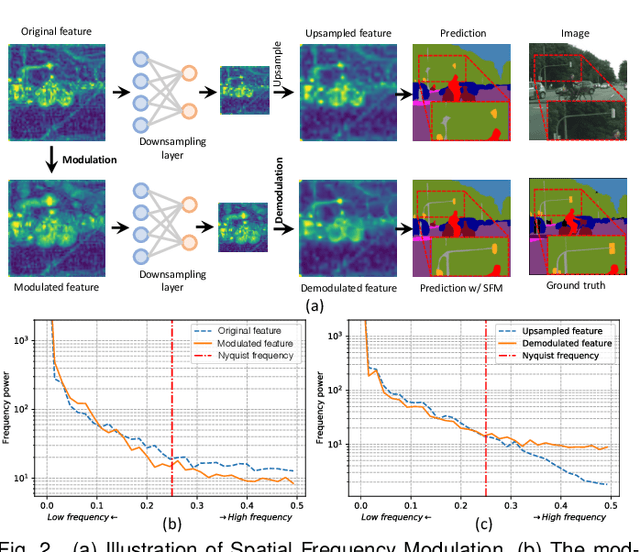
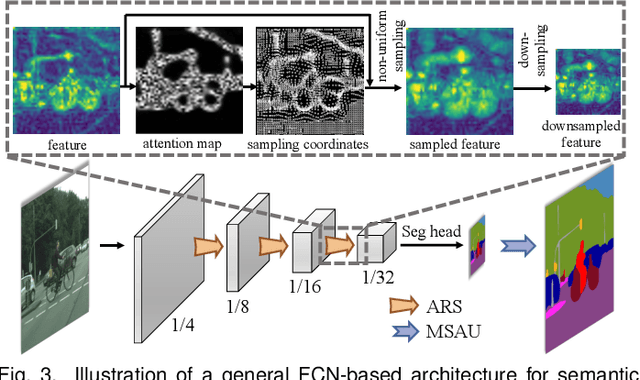
Abstract:High spatial frequency information, including fine details like textures, significantly contributes to the accuracy of semantic segmentation. However, according to the Nyquist-Shannon Sampling Theorem, high-frequency components are vulnerable to aliasing or distortion when propagating through downsampling layers such as strided-convolution. Here, we propose a novel Spatial Frequency Modulation (SFM) that modulates high-frequency features to a lower frequency before downsampling and then demodulates them back during upsampling. Specifically, we implement modulation through adaptive resampling (ARS) and design a lightweight add-on that can densely sample the high-frequency areas to scale up the signal, thereby lowering its frequency in accordance with the Frequency Scaling Property. We also propose Multi-Scale Adaptive Upsampling (MSAU) to demodulate the modulated feature and recover high-frequency information through non-uniform upsampling This module further improves segmentation by explicitly exploiting information interaction between densely and sparsely resampled areas at multiple scales. Both modules can seamlessly integrate with various architectures, extending from convolutional neural networks to transformers. Feature visualization and analysis confirm that our method effectively alleviates aliasing while successfully retaining details after demodulation. Finally, we validate the broad applicability and effectiveness of SFM by extending it to image classification, adversarial robustness, instance segmentation, and panoptic segmentation tasks. The code is available at \href{https://github.com/Linwei-Chen/SFM}{https://github.com/Linwei-Chen/SFM}.
Frequency-Dynamic Attention Modulation for Dense Prediction
Jul 16, 2025Abstract:Vision Transformers (ViTs) have significantly advanced computer vision, demonstrating strong performance across various tasks. However, the attention mechanism in ViTs makes each layer function as a low-pass filter, and the stacked-layer architecture in existing transformers suffers from frequency vanishing. This leads to the loss of critical details and textures. We propose a novel, circuit-theory-inspired strategy called Frequency-Dynamic Attention Modulation (FDAM), which can be easily plugged into ViTs. FDAM directly modulates the overall frequency response of ViTs and consists of two techniques: Attention Inversion (AttInv) and Frequency Dynamic Scaling (FreqScale). Since circuit theory uses low-pass filters as fundamental elements, we introduce AttInv, a method that generates complementary high-pass filtering by inverting the low-pass filter in the attention matrix, and dynamically combining the two. We further design FreqScale to weight different frequency components for fine-grained adjustments to the target response function. Through feature similarity analysis and effective rank evaluation, we demonstrate that our approach avoids representation collapse, leading to consistent performance improvements across various models, including SegFormer, DeiT, and MaskDINO. These improvements are evident in tasks such as semantic segmentation, object detection, and instance segmentation. Additionally, we apply our method to remote sensing detection, achieving state-of-the-art results in single-scale settings. The code is available at \href{https://github.com/Linwei-Chen/FDAM}{https://github.com/Linwei-Chen/FDAM}.
Frequency Dynamic Convolution for Dense Image Prediction
Mar 25, 2025Abstract:While Dynamic Convolution (DY-Conv) has shown promising performance by enabling adaptive weight selection through multiple parallel weights combined with an attention mechanism, the frequency response of these weights tends to exhibit high similarity, resulting in high parameter costs but limited adaptability. In this work, we introduce Frequency Dynamic Convolution (FDConv), a novel approach that mitigates these limitations by learning a fixed parameter budget in the Fourier domain. FDConv divides this budget into frequency-based groups with disjoint Fourier indices, enabling the construction of frequency-diverse weights without increasing the parameter cost. To further enhance adaptability, we propose Kernel Spatial Modulation (KSM) and Frequency Band Modulation (FBM). KSM dynamically adjusts the frequency response of each filter at the spatial level, while FBM decomposes weights into distinct frequency bands in the frequency domain and modulates them dynamically based on local content. Extensive experiments on object detection, segmentation, and classification validate the effectiveness of FDConv. We demonstrate that when applied to ResNet-50, FDConv achieves superior performance with a modest increase of +3.6M parameters, outperforming previous methods that require substantial increases in parameter budgets (e.g., CondConv +90M, KW +76.5M). Moreover, FDConv seamlessly integrates into a variety of architectures, including ConvNeXt, Swin-Transformer, offering a flexible and efficient solution for modern vision tasks. The code is made publicly available at https://github.com/Linwei-Chen/FDConv.
Computation-Efficient and Recognition-Friendly 3D Point Cloud Privacy Protection
Mar 20, 2025



Abstract:3D point cloud has been widely used in applications such as self-driving cars, robotics, CAD models, etc. To the best of our knowledge, these applications raised the issue of privacy leakage in 3D point clouds, which has not been studied well. Different from the 2D image privacy, which is related to texture and 2D geometric structure, the 3D point cloud is texture-less and only relevant to 3D geometric structure. In this work, we defined the 3D point cloud privacy problem and proposed an efficient privacy-preserving framework named PointFlowGMM that can support downstream classification and segmentation tasks without seeing the original data. Using a flow-based generative model, the point cloud is projected into a latent Gaussian mixture distributed subspace. We further designed a novel angular similarity loss to obfuscate the original geometric structure and reduce the model size from 767MB to 120MB without a decrease in recognition performance. The projected point cloud in the latent space is orthogonally rotated randomly to further protect the original geometric structure, the class-to-class relationship is preserved after rotation, thus, the protected point cloud can support the recognition task. We evaluated our model on multiple datasets and achieved comparable recognition results on encrypted point clouds compared to the original point clouds.
InsTaG: Learning Personalized 3D Talking Head from Few-Second Video
Feb 27, 2025



Abstract:Despite exhibiting impressive performance in synthesizing lifelike personalized 3D talking heads, prevailing methods based on radiance fields suffer from high demands for training data and time for each new identity. This paper introduces InsTaG, a 3D talking head synthesis framework that allows a fast learning of realistic personalized 3D talking head from few training data. Built upon a lightweight 3DGS person-specific synthesizer with universal motion priors, InsTaG achieves high-quality and fast adaptation while preserving high-level personalization and efficiency. As preparation, we first propose an Identity-Free Pre-training strategy that enables the pre-training of the person-specific model and encourages the collection of universal motion priors from long-video data corpus. To fully exploit the universal motion priors to learn an unseen new identity, we then present a Motion-Aligned Adaptation strategy to adaptively align the target head to the pre-trained field, and constrain a robust dynamic head structure under few training data. Experiments demonstrate our outstanding performance and efficiency under various data scenarios to render high-quality personalized talking heads.
TdAttenMix: Top-Down Attention Guided Mixup
Jan 26, 2025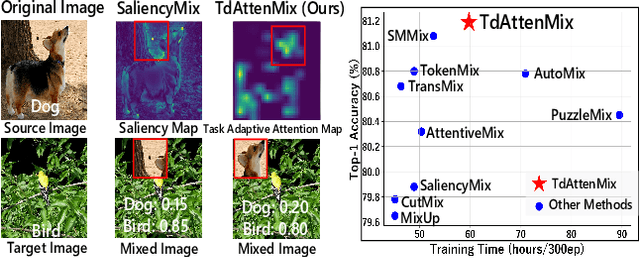
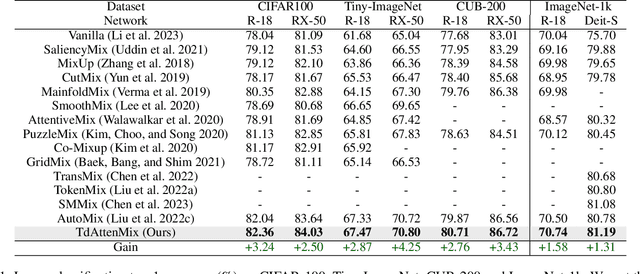


Abstract:CutMix is a data augmentation strategy that cuts and pastes image patches to mixup training data. Existing methods pick either random or salient areas which are often inconsistent to labels, thus misguiding the training model. By our knowledge, we integrate human gaze to guide cutmix for the first time. Since human attention is driven by both high-level recognition and low-level clues, we propose a controllable Top-down Attention Guided Module to obtain a general artificial attention which balances top-down and bottom-up attention. The proposed TdATttenMix then picks the patches and adjust the label mixing ratio that focuses on regions relevant to the current label. Experimental results demonstrate that our TdAttenMix outperforms existing state-of-the-art mixup methods across eight different benchmarks. Additionally, we introduce a new metric based on the human gaze and use this metric to investigate the issue of image-label inconsistency. Project page: \url{https://github.com/morning12138/TdAttenMix}
 Add to Chrome
Add to Chrome Add to Firefox
Add to Firefox Add to Edge
Add to Edge